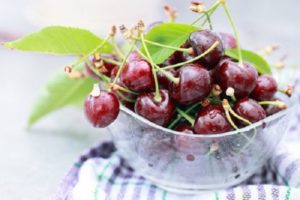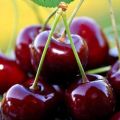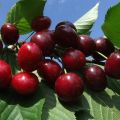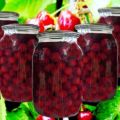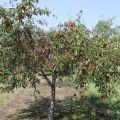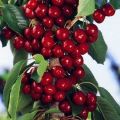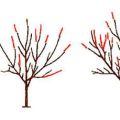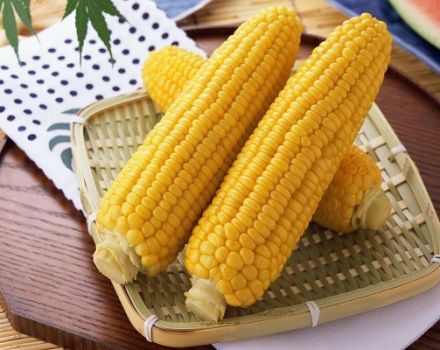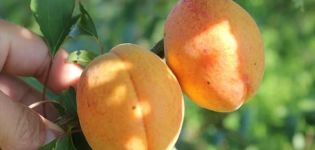Description of the cherry variety Iput and pollinators, choosing a planting site, growing and care
The cherry variety Iput was bred by crossing hybrids 8-14 and 3-36 by Russian scientists Astakhov and Kanshin, officially registered in the State Register of Russia in 1993. Optimal climatic conditions for the growth of this culture are inherent in the territory of the Central and Central Black Earth regions. Cherry Iput attracts many gardeners with the early ripening of fruits, as well as their rich taste.
Description of cherries
Cherry trees of the Iput variety grow to medium size, 4-5 m high. The pyramidal crown is raised and wide. The branches are densely covered with elongated large leaves located on short to medium-sized moderately pigmented petioles. Wavy, slightly concave plate of leaves without pubescence, has a double crenate serration.
Cherry fruits develop on bouquet branches. Inflorescences are formed by 3-4 large flowers with white petals. The corolla according to the description is in the form of a saucer, the calyx is goblet, long stamens are on the same level with the pistil. Buds with embryonic shoots are large, moderately deviated, conical in shape. Egg-shaped flower buds are simple; after fruiting, an almost imperceptible scar remains in their place.
Iput cherries have medium drupes, weighing about 5 g, up to 2 cm in diameter, cordate, rounded upwards with a narrow funnel. Color varies from dark red to almost black as it ripens. Taste qualities of Iput cherries are estimated at 4.5 points. Ripe fruits are well separated from the stalk, are universal in use, contain vitamin C - 11.5 mg per 100 g of product, as well as the following percentages of other useful components:
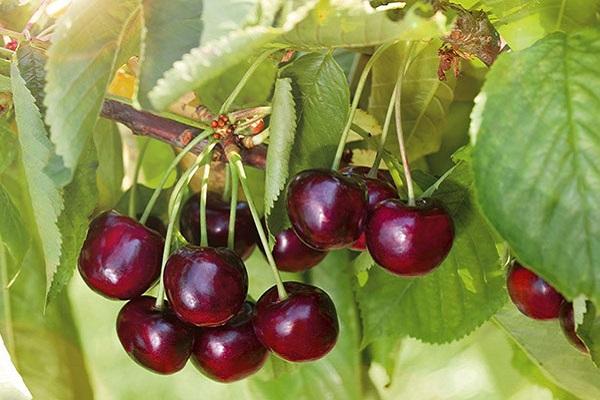
- dry matter - 16.7%;
- sugar - 11%;
- acids - 0.5%.
The skin of the berries is dense, the flesh is juicy, sweet, of moderately dense texture, the juice is deep red. The seeds occupy 5% of the fruit weight.
Characteristics of the Iput variety
Sweet cherry is characterized by medium early maturity, the first harvest can be obtained 4-5 years after the seedling is planted in the garden. The tree bears fruit every year, the ripening period is medium early - the second half of July. High winter hardiness, flower buds are able to withstand frosts of minus 30 ° C. With timely adequate care, the plant has a strong immunity to fungal infections.
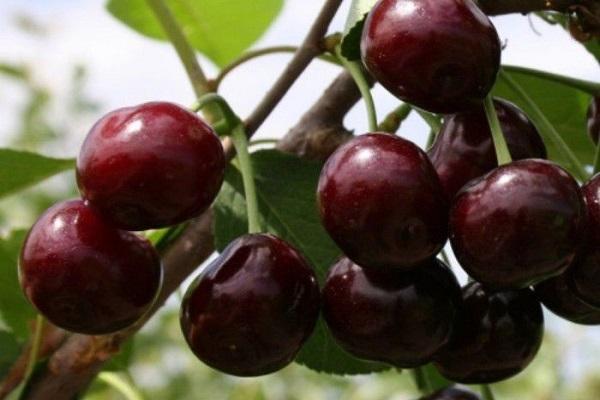
Pros and cons
Cherry trees of the Iput variety are distinguished by regular high yields. More than 30 kg of fruit can be obtained from one adult plant.On an industrial scale, about 70 centners are harvested from 1 hectare, the maximum yield is 145 centners / ha. The dense pulp of drupes is very juicy and sweet, perfect for fresh consumption or making jams, compotes, juices.
Cherry Iput is self-fertile, therefore, several trees are required for pollination. The bone from the pulp is not separated very well. In especially rainy years, the fruits are partially cracked. Also, the negative features of the variety include the poor transportability of the harvested crop.
Cherry growing rules
When laying a garden, it must be borne in mind that the cherry variety is self-fertile. The best pollinators for Iput cherries are the trees of Tyutchevka, Revna, Bryanskaya rosea, Raditsa, Ovstuzhenka. For their growth, the most acceptable climatic conditions of the southern and middle zone.
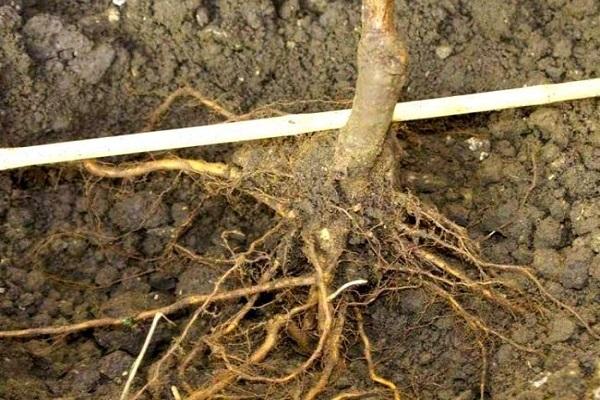
Choosing a place and seedling
The Iput variety grows best on non-acidic moderately moist light soils. Saplings should be planted in calm, well-lit areas. On medium loam and heavy clayey places, there is a higher risk of freezing of trees, more often wood is damaged, fruit buds or crops die. It is also not recommended to choose places with a close location of groundwater (less than 150 cm). If necessary, arrange a drainage channel to drain water.
When choosing a seedling, first of all, pay attention to the trunk. A more prolific tree should have a conductor, sufficiently dense branching, traces of the scion should be determined. The root system should be well developed with strong healthy roots. When transporting them, it is advisable to wrap them with a damp cloth.
Preparing the soil
It is important to properly prepare the soil, precisely at the stage of planting the seedling, in a permanent place. The cherry tree has a powerful root system. When the cherry grows, it will not work to deeply cultivate the soil without damaging the roots.
A hole is dug from 80 to 100 cm in size, about 60 cm deep. The acidic soil is preliminarily extinguished with lime at a consumption of 700 g per 1 m2... Sand is added to the loamy soil. Fertilizers must be applied by mixing with the soil. It is recommended to add 10 kg of rotted humus, about 300 g of superphosphate, 80 g of potash fertilizers.
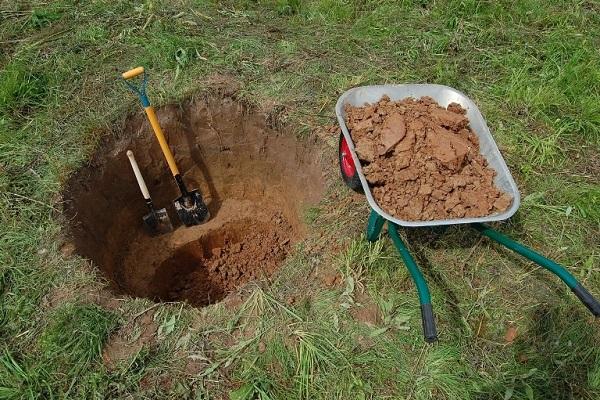
Planting process
In the center of the prepared hole, a mound is built from the upper fertile layer of the earth, on which a tree is placed and the roots are evenly laid out. Sprinkle them tightly with soil so that there are no voids. After planting, the root collar should be 3-4 cm above the soil level. After that, the seedling is watered abundantly, the ground is mulched with peat, straw or humus.
Wood care tips
During the first year after planting, weeds are regularly destroyed in the area around the tree so that the seedling receives maximum nutrition. In the second year, the soil is mulched within a radius of 0.5 m from the trunk, subsequently adding 25 cm each year. Cherries also require regular pruning, fertilization, protection from the sun and frost, and adequate watering.
Top dressing
To ensure the necessary nutritional reserves, the Iput variety must be fed with mineral and organic fertilizers. Moreover, it is better to use them dissolved. They must be brought in at a distance from the trunk, where the roots are located, which most intensively absorb nutrients.
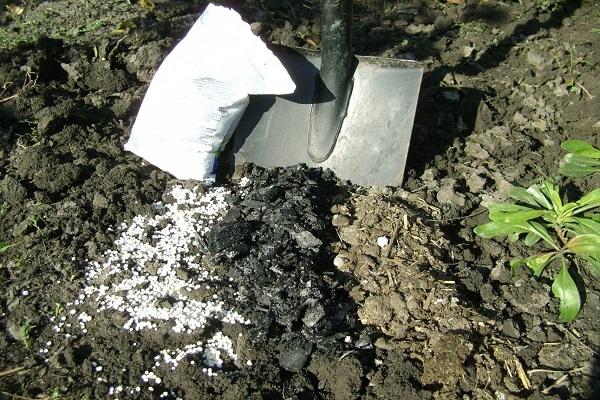
In addition to mineral complexes, many gardeners prefer to use green manure (sowing green manure). Usually honey plants or legumes are used for this purpose. Sowing is carried out in the second half of the cherry growing season, then by autumn you can get the desired herbage, mow and seal it around the tree.
Organization of watering and frost protection
Cherry trees need additional watering - in May during the period of active growth and foliage growth, in June when the fruits ripen, and also in the fall to prepare the tree for frost. A groove is made around adult cherries for watering. In the summer, depending on the amount of precipitation, several abundant watering is done so that moisture flows to a depth of at least 40 cm. After each time, a crust is mulched on the surface of the soil.
It is not recommended to overmoisten the soil during the ripening period of the berries, this will cause the peel to crack.
Preparing for winter, young cherry trees are covered with spruce branches or burlap, each plant is watered with 5 buckets of water. The trunk circle is mulched. To protect against return frosts, a sprinkling method is used, when the tree is irrigated with water before the expected cold snap. When moisture evaporates, the air around the tree is heated.
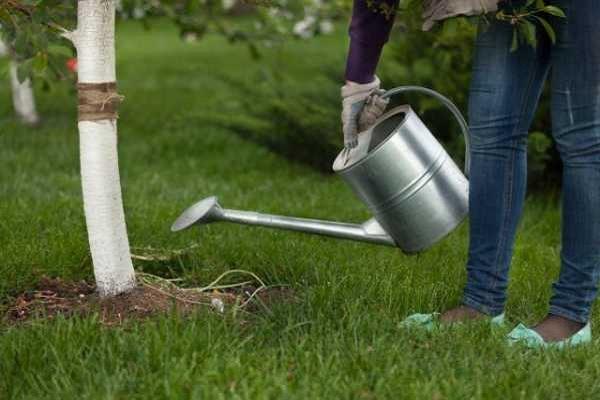
Crown formation
Cherry is cut annually. This allows you to achieve timely regular fruiting, improve the quality of berries, increase the tree's resistance to severe weather conditions and various garden pests.
Systematic correct pruning provides cherries with a long productive period, increases productivity, and increases the strength of the branches.
Correct pruning is aimed at forming a strong skeleton of the cherry crown with an even arrangement of branches, providing sufficient illumination, healing, rejuvenating and prolonging the life of the plant. There are 4 types of scraps:
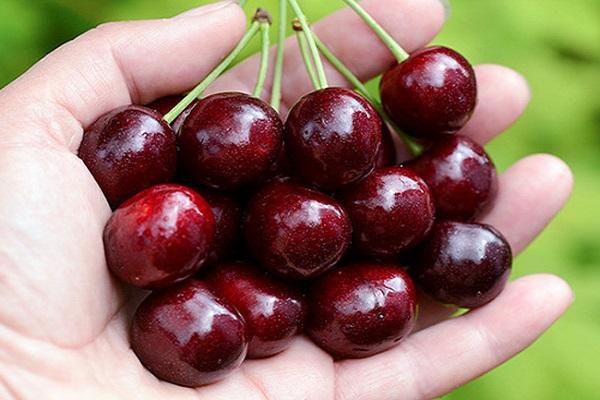
- shortening;
- thinning out;
- sanitary;
- anti-aging.
They begin to regulate the growth of shoots from 2-3 years after planting. Pruning is carried out with the onset of spring. The branches are shortened by a third, while the central conductor should remain 20 cm higher than the skeletal ones. The shortening pruning of cherries Iput also involves the removal of the leading branch with the transfer of growth to the lateral.
Thinning with the removal of branches growing inward is aimed at ensuring the enlightenment of the crown. If you do not regulate the density of cherries, the fruits lose their taste over time. Sanitary pruning is necessary to remove dry, damaged, diseased, frozen branches. Rejuvenation of fruit trees is carried out with a weakening of vital processes.
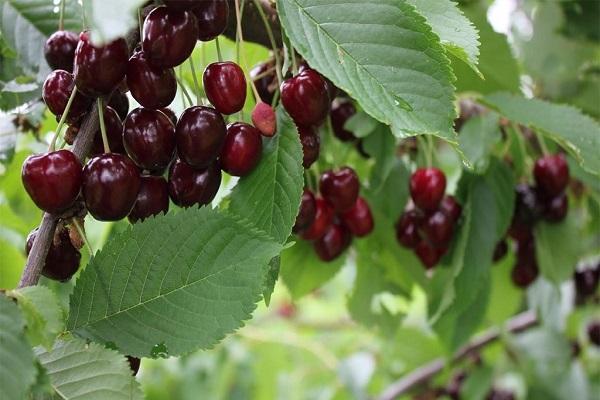
Treatment against diseases and pests
In spring, in April, cherries are irrigated with preparations containing copper, as well as "Kartocid", "Khomycin", "Kuprozan" in accordance with the instructions. The processing is repeated in May. In summer, it is recommended to spray the crown from diseases and pests with iron sulfate.
Preventive processing of cherries Iput is carried out when the entire crop is harvested. In the autumn, before the leaves fall, garden crops and near-stem areas are watered with 500 g of urea dissolved in 10 liters of water. To protect against fungal infections, remove and burn all infected leaves, including fallen ones. If there are signs of perforated spotting, cut off all affected branches.
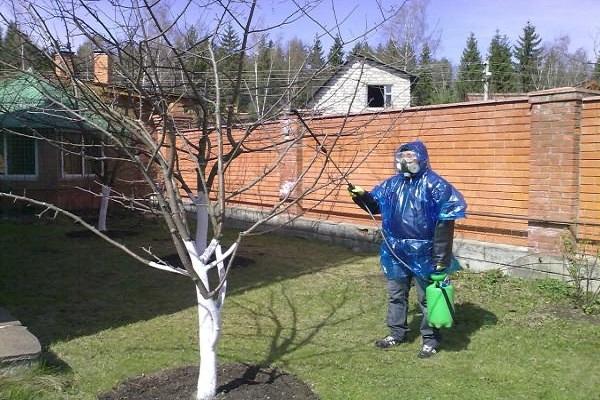
Insecticides are used to combat cherry fly, thick-leg, and unpaired silkworm. They are processed twice, with an interval of 14 days.
For coccomycosis and clotterosporia, Horus is used. A small amount of laundry soap is added to the solution prepared according to the instructions. The first time the cherry crown is sprayed during the development of the buds, the second - after flowering.
Potassium sulfide helps with aphids. The prepared solution is irrigated with cherries in calm dry weather. Of the finished products, you can use Iskra or Inta-vir. Harvesting fruits is allowed at least 20 days after the last treatment.
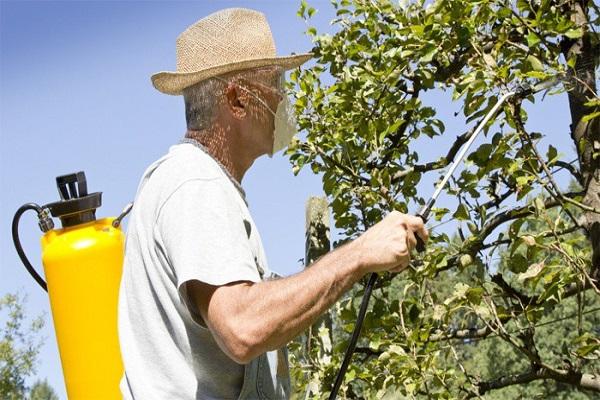
Collection and storage of berries
Cherry fruits of the Iput variety ripen at the same time, so it is convenient to harvest immediately. Cherry berries are poorly tolerated.They are stored at room temperature for no more than 2-3 days, and then they begin to lose their presentation. In refrigerated chambers, the fruits remain usable for up to 20 days.
You can extend the shelf life using special containers with filters and a gas medium. Best consumed fresh or frozen. You can process it into juice, prepare compotes, preserves, jam, make fruit wine.

